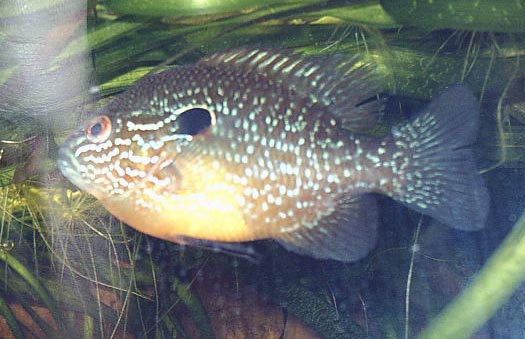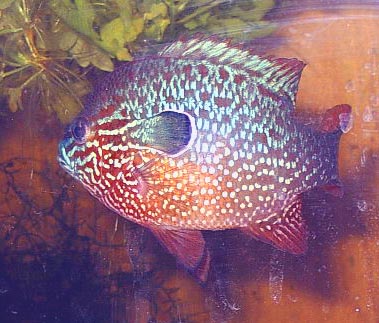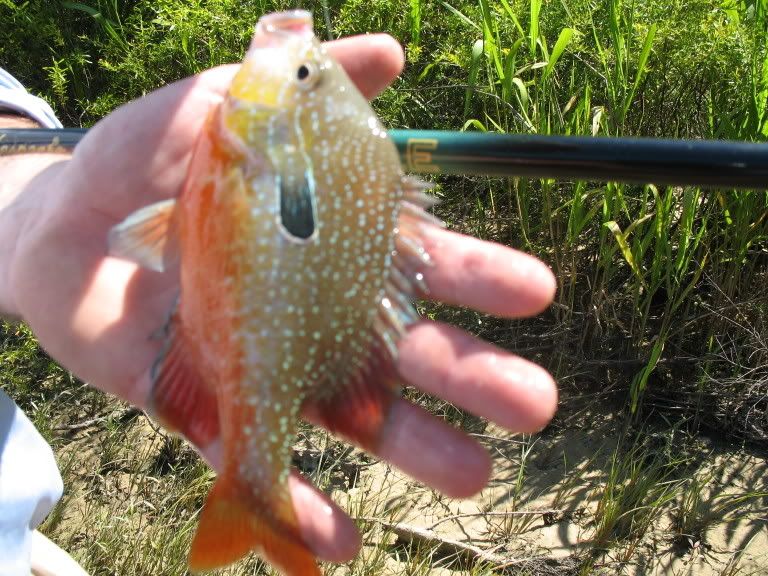Lepomis megalotis vs. peltastes?
#23
 Guest_sandtiger_*
Guest_sandtiger_*
Posted 13 November 2006 - 11:51 PM
#24
 Guest_choupique_*
Guest_choupique_*
Posted 14 November 2006 - 03:12 AM
Sticking to the subject, northern longears, which should actually be called the Great Lakes longear ( because of their distribution) often act much differently than 'centrals'. They normally are found in habitat that you associate with green sunfish. Shallow , very shallow, thick cover. Often in murky still water. Not that they don't occur in clear fast flowing streams, but in most cases try to find the silty backwaters of these streams. Not to mention their feeding habits.
Until I saw the pictures posted above, the Kankakee River is the only place I heard the two existed side by side, and no intergrades were found. Some of those look like intergrades. That is interesting, since I think it was two seperate samples that found no intergrades there.
Going over into the dollar sunfish part of the discussion, there are distinct differences noted between the eastern form, the western form, and the pennisular Florida form. We seen the eastern and western form in pictures posted above. Those differences are pretty clear, the pennisular FL dollar is smaller, with different overall coloration on the body. The habits of each type differ too. Not that long ago dollars and longears were not different fish in books which fish don't read apparently.
All that said, my opinion is the so called northern longear is not a central longear of any kind. If the two picturs below are the same species of fish, then strawberry and buffalo darters are the exact same fish.
#25
 Guest_smbass_*
Guest_smbass_*
Posted 14 November 2006 - 10:05 AM
#26
 Guest_choupique_*
Guest_choupique_*
Posted 14 November 2006 - 01:21 PM
I have played with the thought that the northern longear might be closer to a dollar. The smaller size was one thing that made me think of that besides the other things discussed. I have kept all of them in various combinations. The interesting thing is that the northern looks like dollars in porportion until they get to the biggest size. Then they blend in more with central longears. Maybe if dollars could reach six inches or so they would do the same?
All these fish are/were in a subgenus ictheles. Not sure if any of the other sunfish are or not. That is why I think splitting is useful, a roadmap to understand how the fish are related. I get perturbed when splitting starts putting fish apart in a way you no longer can understand the relationships. Like Chaenobryttus, maybe Paralepomis or something like that would work better?
#28
 Guest_bearskookums_*
Guest_bearskookums_*
Posted 17 December 2006 - 08:11 AM
since we are all posting long ear picts
this one came from the Escatawba River, Jackson county, MS
To me this one looks more like a Red breast sunfish...its got that fine vertical spots along its body...and that excessively long ear flap...
http://www.dgif.virg...20Redbreast.jpg
http://www.georgiasp...m/aa051203a.jpg
#29
 Guest_smbass_*
Guest_smbass_*
Posted 18 December 2006 - 12:30 AM
To me this one looks more like a Red breast sunfish...its got that fine vertical spots along its body...and that excessively long ear flap...
[/quote]
A redbreast would have no outsine to the opercle flap, this fish definately has an outline on the opercle. The flap would also be jet black none of the blue flecs on it as this fish has.
here are a few redbreast pics, One young one that i caught on a fly rod and two big guys at the GA aquarium.
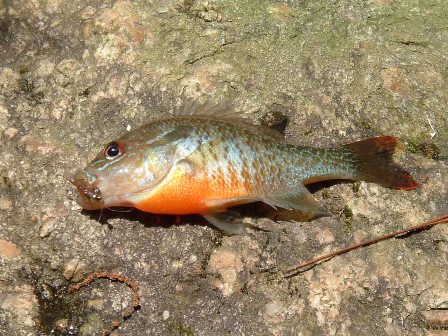
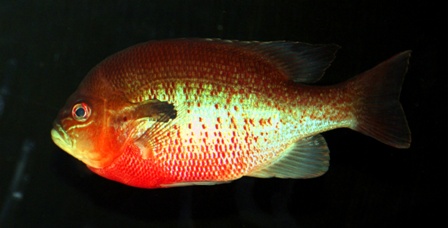
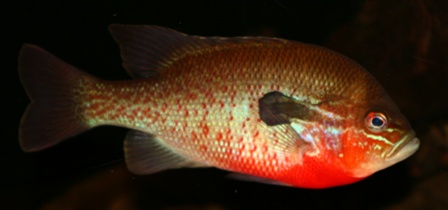 [
[
#30
 Guest_dsmith73_*
Guest_dsmith73_*
Posted 18 December 2006 - 12:30 PM
quote ]
To me this one looks more like a Red breast sunfish...its got that fine vertical spots along its body...and that excessively long ear flap...
A redbreast would have no outsine to the opercle flap, this fish definately has an outline on the opercle. The flap would also be jet black none of the blue flecs on it as this fish has.
I agree here with you as far as the margin around the ear flap, but redbreast do not have to have an all black ear flap. Adult breeding males can have some spangling in the ear flap. See here:
http://sc.nativefish...is_auritus.html
#31
 Guest_nativecajun_*
Guest_nativecajun_*
Posted 21 January 2007 - 07:08 AM
#32
 Guest_farmertodd_*
Guest_farmertodd_*
Posted 23 January 2007 - 12:23 AM
The molecular data will be the most convincing, as it'll be able to tease apart genetic stocks, and with this species, will most likely demonstrate the route of immigration. With that in mind, I've always been particularly impressed with Ray Wolff's eyes and mind for sunfish, and a while ago, I remember him calling peltastes the "Great Lakes Sunfish". This came back to mind recently as I saw data released on other game species that aren't necessarily cold water species (smallmouth and walleye), and I think Ray is really on to something.
I'm not sure of everyone's familiarity with post-glacial lakes and connections... Basically, in the late glacial age, there was a big hunk o' ice blocking water from escaping to the east, with tons of meltwater to go somewhere. This created a series of ice dammed lakes with drainages that went different directions, sometimes out the Wabash River to the Gulf, sometimes out the east in the Mohawk / Hudson River connection to the Atlantic, but an important connection to this conversation is out the Illinois River, again out to the Gulf.
And this is a good chance to explain all the pieces. If you're not really sure how the genetics thing works, just think of it like this... The genes are kind of like a big combination lock. Most of the time what geneticists are looking for are changes in the combination (a mutation), which happens at a known rate of change over time for various parts of the genetic code. By doing this, they're able to cluster populations as discretely as they'd like by increasing or decreasing the resolution that they're examining. This would be akin to zooming in and out in an application like Google Earth or Mapquest.
When someone comes forward saying "we feel we have evidence that this is a new species", they're looking at a low resolution with the changes. Picture looking at "The Midwest" instead of "Ohio". If from that far distance, you see definate trends, then you've built a case for a split. If there aren't trends, the overall genetic diversity is still shared among the entire population, and you have no case for two distinct species (no matter if they look like a bluegill or a green sunfish, or both
However, you might also zoom into "Ohio" and see what trends you can find there. With this evidence, you're creating a case for paths of immigration. If you weren't familiar with the nuts and bolts, you might now see how powerful these tools are for determining these evolutionary relationships.
Now back to the topic... There's been a debate on the route of invasion of peltastes (among others), wether it was the Wabash connection, the Illionis connection, or even an Allegheny or Mohawk connection invading from the east. Everyone agrees that the fish around the Great Lakes are different than their southern counterparts. But where did they come from, and where did they hang out while this habitat was under a mile of ice? Were there two refugia, one in the west and one in the east? Or one in the west and one in the south? Or just in the south?
So the state of NY lists the "northern longear" as Endangered and began doing genetic stock work to see where they might get brood stock to invigorate their stocks. Most of the work, to my understanding is being done at SUNY Brockport, and one of their grad students had posted on the email list, it'd be great to hear from them here.
Anyway, word on the street was that they couldn't find anything different all the way through Michigan or in the Maumee River. This may or may not have figured into Michigan's decision, but it certainly supports their decision. Some of the folks I work with also looked at walleye and smallmouth stock, and find a similar trend in those species. I laughed a maniacal evil laughter the first time I saw the chart because I happen to know a little about this geology thing too. Wondered how that tied in?
So, what seems to have happened was they made way through marshes along the southern shore of Lake Michigan and entered into Lake Huron through the Grand River into Lake Huron's predecessor, Glacial Lake Algonquin.
Lake Erie (this is where it gets cool!), at the time, was a closed basin... It was mainly a series of marshes, as the Niagra Gorge had opened up and completely drained what was known as Glacial Lake Warren in a catastrophic event, and there wasn't much meltwater coming into the watershed to replenish it as a lake. A final lobe of ice separated the watersheds of Erie and Algonquin, and in the meantime, Erie began to replenish its depth with meltwater and also what's known as isostatic rebound. That is, to the east at Niagra, the land fractured and rose up on a "seam"of sorts, where the land to the south was released while the land to the north was still under the pressure of the ice.
Anyway, when that lobe finally receeded, and a connection was recreated, viola... Here came the walleye, the smallmouth, and the northern longear. Also makes a verrrry convenient explaination for the blue pike! (wink, wink, nudge, nudge)
This is very convincing evidence toward a split now that we know the stocks in the lower Lakes are for the most part a distinct stock among their grouping. Where someone needs to pick up the ball is on the Wisconsin and Illinois stocks, and I hope someone out there is working on it, because this is a slam dunk. There's little question in my mind that they should be split, and perhaps there's another couple cryptic fauna in the southern and plains populations. That may not be as obvious, as they may have moved apart from the same Wisconsin Age refugia in the south.
The thing that's really curious to me is where the peltastes species hung out during the ice? I imagine Iowa would have been great habitat for cool and heavily vegetated waterways. Further down the Mississippi and up the Missouri would have been too turbid with all the glacial outwash.
It's fun to think about anyway.
And I hope some day we get to call peltastes after Ray's insight... The Great Lakes Sunfish.
Ahhhh... Something I wanted to write about today hehheh. Back to the research tomorrow!
Todd
#34
 Guest_smbass_*
Guest_smbass_*
Posted 23 January 2007 - 12:43 AM
#36
 Guest_Brooklamprey_*
Guest_Brooklamprey_*
Posted 23 January 2007 - 11:39 AM
#38
 Guest_farmertodd_*
Guest_farmertodd_*
Posted 23 January 2007 - 09:07 PM
For the glacier stuff... This site is really nice:
http://www.emporia.e...y1/gl_form.html
Around 12,000 is where the draining event of Warren took place, give or take five hundred. And then it was the closed basin, as described. But you can see where "Huron" reconnected finally there about 3500.
What I state incorrectly last night was that there was an ice break that reconnected the two lakes. The rising of the land and the filling of basins was ultimately the connection of Huron and Erie, not the retreat of the Huron Lobe.
But you can see how "Erie" set alone from about 12,000 until somewhere near 6,000 (Blue pike anyone?
Wiki, also is of course, a great jumping off place:
http://en.wikipedia....ial_Lake_Maumee
As for genetics... Again, as I was telling Uland... Genetics is pretty danged easy once you get most of the Geneticists uninvolved lol. Unfortunately, they're the ones who write all the books and teach the classes. Same thing with Statisticians. Ugh.
Brian, they're more abundant just over the border in Michigan than they are Maumee. The upper Huron is crawling with them in riverine segments between lakes, and they're not exactly hard to come by in the Raisin either. But back in the day, man, the Maumee had to have unreal populations. And I've yet to see any from Michigan that have that fiery red base. I think that's some geneotypic variation.
Man. When our species has breathed it's last... There are two crimes against nature present that will be part of the case against us remembered in the molecules of All that there Is:
The channelization and draining of the Maumee and the Kankakee basins.
The Kankakee being the greater sin, as we all know people who were alive when it happened!
Todd
#39
 Guest_fundulus_*
Guest_fundulus_*
Posted 23 January 2007 - 10:28 PM
As for genetics... Again, as I was telling Uland... Genetics is pretty danged easy once you get most of the Geneticists uninvolved lol. Unfortunately, they're the ones who write all the books and teach the classes. Same thing with Statisticians. Ugh.
Todd
Todd, I thought you were on your way to becoming a pedigreed gene jockey? HA! But seriously, to understand biological diversity for any organisms it helps to have a backgroud in geology and earth processes. The planet is in constant flux.......
#40
 Guest_farmertodd_*
Guest_farmertodd_*
Posted 24 January 2007 - 09:37 AM
Todd, I thought you were on your way to becoming a pedigreed gene jockey? HA!
Yeah. I've seen the light, the theory and now the applications of the theory are incredibly powerful and interesting tools. And I see some glaring omissions from the literature, such as the toungtied minnow, Exoglossum laurae , that have incredibly disjunct populations, and I think, should be at a minimum, managed as separate species. What I really can't believe is that Ohio hasn't put a standing bid for funding on this species, because it most likely should be a FED candidate at worst. That makes a lot of money available for the protection of the Mad and Little Miami Rivers, and at a minimum, makes a lot better habitat for smallmouth and other game species downstream! Duh! lol
But spliting Ulocentra by the river mile... Nah, not anything I'm very interested in
Speaking of using sport fish to pay for natural history of non-game (the bill has come for all those danged trout guys!)... I noticed another interesting distribution last night that you all may like to do some analysis on now that you're glacial geology savvy. The weed shiner, Notropis texanus.
You guys down south probably realize that the common name may have more to do with abundances than it's habitat. But look at this:

http://www.seagrant....ish/becker.html
Modified from Fishes of Wisconsin, Becker, 1983.
And here's a little better resolution in Michigan, if interested:
http://www.dnr.state...maps/nottex.pdf
Look familiar at all? If the range were widespread in Michigan and then patchy east, who would this be? This isn't a coincidence.
Ironcolor shiner, spotted sucker, pugnose minnow... They all do (did) this.
Neat stuff.
Todd
Reply to this topic
0 user(s) are reading this topic
0 members, 0 guests, 0 anonymous users


